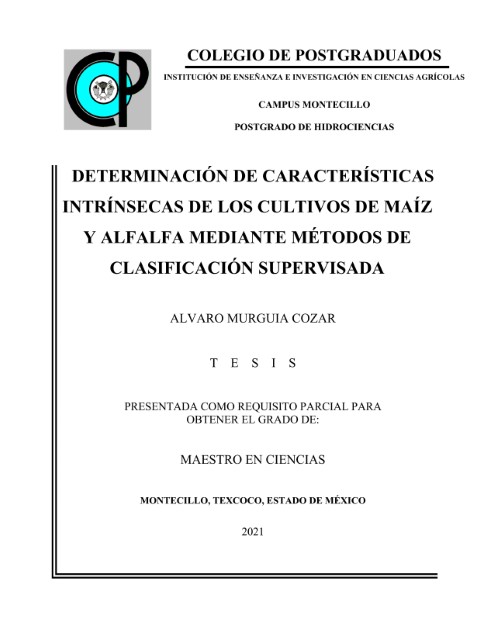
Fecha: 2021-10
ALVARO MURGUIA COZAR, M. C. Colegio de Postgraduados, 2021.
RESUMEN.
El crecimiento de la población está haciendo necesario
incrementar el área agrícola para la producción de alimentos, lo que se refleja
en el aumento de las extracciones de agua, el nivel de degradación de suelos y
la escasez de agua. A nivel mundial los países buscan alcanzar la seguridad
alimentaria de sus naciones de manera sustentable, es por ello, que incrementar
la superficie agrícola, la productividad agrícola y la intensidad del cultivo,
haciendo un uso eficiente del agua y evitando al máximo la degradación de los
suelos y la contaminación del agua, son objetivos claves para alcanzar la
seguridad alimentaria. El monitoreo de cultivos mediante procesamiento de
imágenes satelitales y la aplicación de modelos de clasificación supervisada son
estrategias tecnológicas que puede emplearse en la generación de información
básica para la estimación de parámetros biofísicos de los cultivos que permitan
maximizar la producción de alimentos. El propósito de esta investigación fue
determinar los indicadores y características principales que permitan clasificar
las etapas fenológicas de los cultivos de maíz (Zea mays L.) y alfalfa (Medicago
sativa) en imágenes satelitales Sentinel 2 mediante modelos de clasificación
supervisada. Los datos de entrenamiento se obtuvieron a través del monitoreo de
parcelas cultivadas durante un ciclo agrícola. La extracción de indicadores y
características se realizó a 41 imágenes Sentinel 2 adquiridas durante las
fechas de monitoreo. Con estas imágenes se calcularon indicadores de textura,
vegetación y color para entrenar clasificadores supervisados: discriminante
lineal (DL), máquina de soporte vectorial (SVM), K vecinos más cercanos (KNN) y
red neuronal perceptrón multicapa (MLP). Para el cultivo de maíz, el modelo que
mejor clasificó su fenología fue la red neuronal MLP con precisiones mayores al
82 % para las clases, 92 % general y coeficiente kappa de 85 %. En el cultivo de
alfalfa, el mejor modelo de clasificación fue la red neuronal MLP con una
precisión general de 87 % y coeficiente kappa del 80 %.
Palabras Clave: máquina de soporte vectorial, red neuronal perceptrón multicapa,
característica, imagen satelital, Sentinel 2.
DETERMINATION OF INTRINSIC CHARACTERISTICS OF CORN AND ALFALFA CROPS USING SUPERVISED CLASSIFICATION METHODS.
ABSTRACT
Population growth is making it necessary to increase the agricultural area for food production, which is reflected in the increase in water withdrawals, the level of soil degradation and the scarcity of water. At the global level, countries seek to achieve the food security of their nations in a sustainable way, which is why, to increase the agricultural area, agricultural productivity and the crop intensity, making efficient use of water and avoiding as much as possible the pollution of Soils and water, are key objectives to achieve food security. The monitoring of crops through satellite image processing and the application of supervised classification models are technological strategies that can be used to generate basic information for estimate biophysical parameters of crops that allow maximizing food production. The purpose of this research was to determine the main indicators and characteristics that allow classifying the phenological stages of corn (Zea mays L.) and alfalfa (Medicago sativa) crops with Sentinel 2 satellite images using supervised classification models. The training data were obtained by monitoring cultivated plots during an agricultural cycle. The extraction of indicators and characteristics was carried out to 41 Sentinel 2 images acquired during the monitoring dates. With these images, indicators of texture, vegetation and color were calculated to train supervised classifiers: linear discriminant (DL), vector support machine (SVM), K nearest neighbors (KNN) and multilayer perceptron neural network (MLP). For the maize crop, the model that best classified its phenology was the MLP neural network with precisions greater than 82% for the classes, 92% overall and a kappa coefficient of 85%. In alfalfa crop, the best classification model was the MLP neural network with an overall precision of 87% and a kappa coefficient of 80%.
Keywords: support vector machine, multilayer perceptron neural network, feature, satellite image, Sentinel 2.